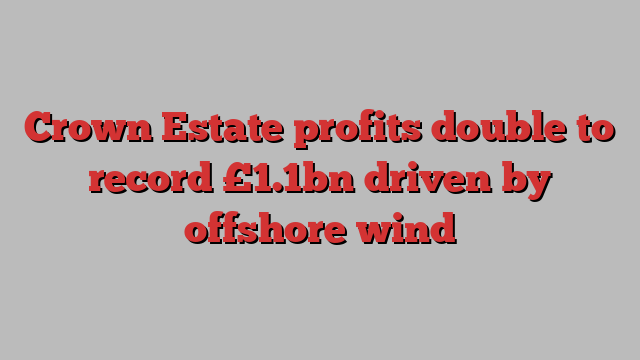
Unlock the Editor’s Digest for free
Roula Khalaf, Editor of the FT, selects her favourite stories in this weekly newsletter.
Profits from the British monarchy’s legacy portfolio of land and property holdings have more than doubled to a record £1.1bn, as it continues to reap the benefits of offshore power deals.
The Crown Estate said on Wednesday its profits had risen by £658.1mn in the last financial year — up from £442.6mn — thanks largely to fees charged to offshore wind developers.
The £15.5bn estate, which plays a significant role in British royal finances, owns a swath of property and a lucrative stretch of seabed up to 12 nautical miles wide that surrounds England, Wales and Northern Ireland.
It has benefited from growth in the sector that it said helped to deliver £4bn of Treasury income over the past decade.
However, Crown Estate chief executive Dan Labbad warned that bumper income from recent wind deals would probably only continue for one more year before “normalising”.
The boost comes from option fees paid to secure sites for offshore wind farms, which Labbad acknowledged “are short term in nature” and will ultimately transition into steadier revenues as more wind farms become operational.
The offshore wind sector has been a success for the UK, growing rapidly over the past two decades to generate 17 per cent of the country’s electricity in 2023.
There is roughly 15GW of operational offshore wind capacity installed in UK waters, making it the largest market outside of China.
The technology is key to the government’s goal of cutting carbon emissions from electricity supplies to net zero by 2030. In its election manifesto, Labour said it wanted offshore wind capacity to grow to 55GW by 2030.
However, whether it hits that target will depend in large part on the success of the latest annual auction round for support contracts from the government, a separate process from the Crown Estate’s seabed leasing.
Offshore wind developers shunned last year’s round, complaining the support on offer was too low to offset the rising costs of equipment and financing.
Labbad said the estate’s underlying profits would continue to grow thanks to a recovery in its commercial property holding following the hit from the Covid-19 pandemic.
The estate’s prospect have also been boosted by new legislation confirmed in the King’s Speech that will allow the estate to borrow for the first time.
The Crown Estate will target a “conservative” level of debt of about 10-20 per cent of assets over time, he added.
The monarch’s historic estate pays its profits into the Treasury. The estate’s income from two years previously is used as the benchmark for the “sovereign grant” — a payment to the monarch to support his official duties.
In July last year, the regular review of the size of the grant recommended it should decrease from 25 per cent of the Crown Estate’s profits to 12 per cent, partly to take account of the bumper profits from offshore wind.
The government said at the time this would maintain the grant at £86.3mn, the same as the previous year, in 2024-25, before rising 45 per cent to £124.8mn in 2025-26 and £126mn in 2026-27.
The grant had been increased 10 per cent in 2016 to help pay for major renovations of Buckingham Palace. The King has no direct role in running the estate, which is overseen by an independent board.
In its London portfolio, the estate said “returning demand for office space” contributed to revenue growing 3.2 per cent to £229.7mn.
Like other big landlords, the value of its holdings, which span St James’s and Regent Street, was hurt by rising interest rates, falling £443.3mn to £8.4bn.
Labbad said there were “signs that property valuations may be approaching the bottom of the cycle” and would start to recover, with rents on shops and offices already showing growth.